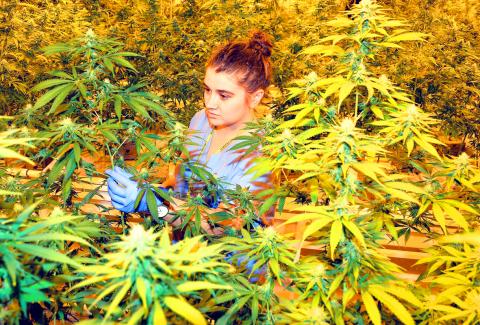Even for a puppy, Kat Donatello’s black lab, Austin, was hyperactive. After experimenting with natural supplements on her older dog, Brady, Donatello slipped the puppy a special biscuit.
“It just kind of took the edge off of him,” she said.
The treat contained cannabidiol, better known as CBD, a chemical compound extracted from the marijuana plant.

Photo: AP
The CBD supplements were expensive, and options for pet treats were limited, Donatello said.
“So I started spending my winters baking dog biscuits,” she said, adding that she tinkered with the recipe before launching her CBD-laced biscuit company, Austin + Kat, earlier this year.
Along with Therabis and Treatibles, Austin + Kat is one of several cannabidiol-for-dogs businesses that have popped up in the past two years, a time period during which CBD pet product sales doubled in the US, according to data kept by cannabis industry analytics firm MJ Freeway.
It is the newest trend in the US’ booming half-billion dollar animal supplements market, which is expected to grow by more than US$150 million in the next four years.
CBD is one of over 80 active cannabinoid chemicals in marijuana, according to the National Institute on Drug Abuse.
Unlike tetrahydrocannabinol (THC), CBD does not create a euphoric sensation. In other words, these biscuits will not get your dog high, but there is some debate as to what effect the compound has on our furry friends and whether they should be consuming it at all.
Academic research about CBD’s affect on animals is nearly nonexistent, and the US Food and Drug Administration has not approved marijuana use in animals. Despite this, some veterinarians recommend their use, and producers say pet stores are increasingly beginning to carry CBD treats. Treatibles is even in talks to be sold at a big box pet store, though an executive would not reveal which one, as the deal is still pending.
Veterinarians’ views on the supplement vary. When asked about the effectiveness of CBD in dogs, veterinarian Robert Goggs said there is “virtually no evidence in the veterinary literature on this.”
By contrast, veterinarians Robert Silver and Gary Richter recently hosted a course on the cannabis-dedicated learning Web site Green Flower entitled the “Cannabis for Pets Masterclass.”
Contacted by phone, Richter conceded that scholarly literature is lacking.
“A lot of what we’re using is extrapolated data from humans, as well as just real world experience on what works,” he explained.
If it works for humans, he said, it could work for dogs.
In lieu of research, the CBD-for-dogs industry cites supportive veterinarians and customer testimonials as evidence of the products’ effectiveness.
On Treatibles’ Web site, an interview with the owner of mixed-breed pup Shelby shows how the dog, plagued with anxiety and fear, was able to settle down after eating a laced treat.
Human studies have linked CBD to anti-seizure, anti-inflammatory and anti-anxiety effects. In findings presented to the US Senate on International Narcotics Control in June last year, National Institute on Drug Abuse director Nora Volkow said CBD could potentially aid those suffering from Alzheimer’s, stroke, multiple sclerosis and Parkinson’s.
Despite the largely positive feedback in Volkow’s presentation, she warned that additional research on CBD is necessary.
The Drug Enforcement Administration (DEA) agrees and hopes to review further scientific studies on CBD.
CBD is often purchased online, which is technically a violation of US federal law, according to DEA spokesman Russell Baer.
“Extracts or derivatives from the cannabis plant are Schedule I controlled substances — just like the plant itself,” Baer said in an e-mailed statement. “There is widespread illegal distribution of purported CBD products — regardless if they are derived from the marijuana plant or hemp plant,” he added.
Understandably, the DEA’s attention is not on CBD at a time when the US faces an opioid crisis, and sterilized cannabis seeds can be legally used in animal feed mixture.
When asked about the legality of the business, Therabis called it a “complex situation.”
Austin + Kat’s Donatello expressed frustration with the DEA’s position in light of the US Controlled Substances Act and her ability to purchase CBD products at Walmart.com.
Treatibles did not reply to a request for comment.
There is also the matter of ethics.
Humans can verbally express discomfort when trying a new treatment. Dogs cannot.
“If the proper administration of marijuana can truly relieve dogs’ pain, then they should be given the same consideration that humans in pain are given, with regular doses to help reduce their misery,” People for the Ethical Treatment of Animals senior vice president Daphna Nachminovitch said. “But it’s an entirely different matter to amuse oneself by getting the cat drunk or the dog high.”
While the researchers debate what, exactly, CBD can do for Fido, investors are excited by its increasing popularity, which has been buoyed by the US legalization of cannabis (for humans) and increased dialogue about the medicinal properties of marijuana.
Treatibles founder Julianna Carella has seen sales explode “like wildfire” over the past two years.
Therabis has experienced equally explosive growth in its first year of business; since February, the company has seen revenue quadruple, and sales have grown 30 percent month-on-month, according to Joe Hodas, chief marketing officer of the treat brand’s parent company.
Troy Dayton, cofounder of the Arcview Group, an Oakland, California-based investment firm, was a skeptic before he saw the sales numbers.
“If humans are noticing in droves all the different ways where cannabis products can have utility for them, then surely there will be a massive application [for animals],” he said.
Over the past two years, Arcview has been involved in fundraising efforts for two CBD pet-product companies.
Dayton anticipates that additional capital will follow, particularly from investors leery of getting into the recreational cannabis market, which is legally murky.
“There’s a lot of opportunity” in the CBD market, Dayton said.
“I’m not surprised at all that the space is growing,” Carella said. “There’s so many pet owners that would do just about anything to relieve their animals’ suffering.”

CHIP RACE: Three years of overbroad export controls drove foreign competitors to pursue their own AI chips, and ‘cost US taxpayers billions of dollars,’ Nvidia said China has figured out the US strategy for allowing it to buy Nvidia Corp’s H200s and is rejecting the artificial intelligence (AI) chip in favor of domestically developed semiconductors, White House AI adviser David Sacks said, citing news reports. US President Donald Trump on Monday said that he would allow shipments of Nvidia’s H200 chips to China, part of an administration effort backed by Sacks to challenge Chinese tech champions such as Huawei Technologies Co (華為) by bringing US competition to their home market. On Friday, Sacks signaled that he was uncertain about whether that approach would work. “They’re rejecting our chips,” Sacks

Taiwan’s exports soared 56 percent year-on-year to an all-time high of US$64.05 billion last month, propelled by surging global demand for artificial intelligence (AI), high-performance computing and cloud service infrastructure, the Ministry of Finance said yesterday. Department of Statistics Director-General Beatrice Tsai (蔡美娜) called the figure an unexpected upside surprise, citing a wave of technology orders from overseas customers alongside the usual year-end shopping season for technology products. Growth is likely to remain strong this month, she said, projecting a 40 percent to 45 percent expansion on an annual basis. The outperformance could prompt the Directorate-General of Budget, Accounting and

NATIONAL SECURITY: Intel’s testing of ACM tools despite US government control ‘highlights egregious gaps in US technology protection policies,’ a former official said Chipmaker Intel Corp has tested chipmaking tools this year from a toolmaker with deep roots in China and two overseas units that were targeted by US sanctions, according to two sources with direct knowledge of the matter. Intel, which fended off calls for its CEO’s resignation from US President Donald Trump in August over his alleged ties to China, got the tools from ACM Research Inc, a Fremont, California-based producer of chipmaking equipment. Two of ACM’s units, based in Shanghai and South Korea, were among a number of firms barred last year from receiving US technology over claims they have

BARRIERS: Gudeng’s chairman said it was unlikely that the US could replicate Taiwan’s science parks in Arizona, given its strict immigration policies and cultural differences Gudeng Precision Industrial Co (家登), which supplies wafer pods to the world’s major semiconductor firms, yesterday said it is in no rush to set up production in the US due to high costs. The company supplies its customers through a warehouse in Arizona jointly operated by TSS Holdings Ltd (德鑫控股), a joint holding of Gudeng and 17 Taiwanese firms in the semiconductor supply chain, including specialty plastic compounds producer Nytex Composites Co (耐特) and automated material handling system supplier Symtek Automation Asia Co (迅得). While the company has long been exploring the feasibility of setting up production in the US to address